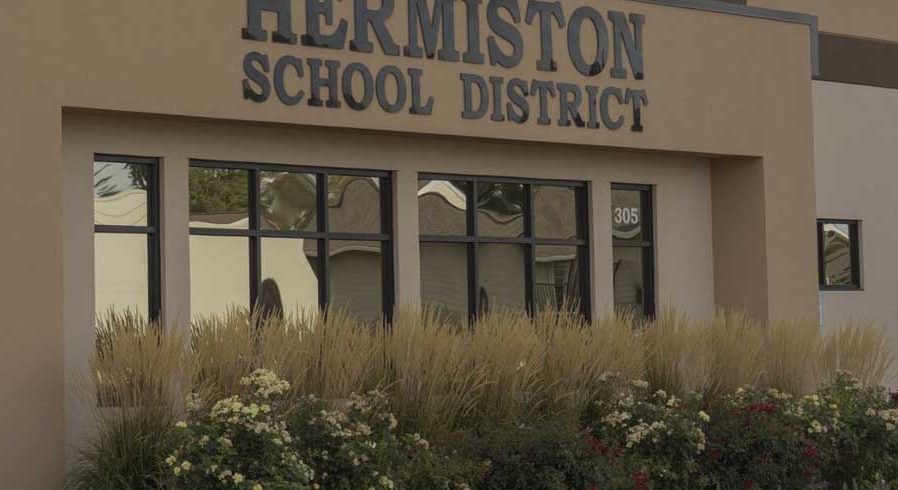¿Se habla Español?
Published 1:44 am Sunday, October 28, 2007

- Bilingual teacher Heather Sherman works on vocabulary with Hispanic students at Sunset Elementary School in Hermiston. <i>Staff photo by E.J. Harris</i>
It may be time to learn Spanish.
The Hispanic population is increasing at dizzying speed. Hispanics overtook blacks as the country’s largest minority group early this century. The U.S. Census Bureau projects the number of Latinos counted in the last census – 35.6 million – will triple by 2050 to about 102.6 million, or almost a quarter of the nation’s population.
The demographic momentum is fueled by high Latino birth and immigration rates that leave non-Hispanics in the dust, demographically speaking. The national trend is showing up locally in places like Hermiston, Boardman, Umatilla, Irrigon, Milton-Freewater and, to a lesser extent, Pendleton and other locales. It’s also changing the landscape on Main Street and reaching deeply into hospitals, schools, businesses and police patrol cars.
Bilingual applicants have a step upDoreen Quick, manager of Hermiston’s Bank of America branch, said bilingual employees are essential. Though the bank has two bilingual tellers and one bilingual personal banker, Quick said, “I never have enough bilinguals.
Communicating fluently with Latino customers is good business, Quick said.
“It only does a business good to serve the needs of the Hispanic community,” she said.
Kristin Connell, manager of Express Personnel, a Hermiston temp agency, said job applicants who speak both Spanish and English are a valuable commodity. Many of the employers for whom she fills job orders ask for bilingual candidates only, especially for office and retail positions.
“Things have really changed,” she said. “When I started 13 years ago, we sent monolinguals out like crazy – over the years, companies have changed their requirements.”
Language confusion frustrates police Umatilla County Sheriff John Trumbo said conversing during traffic stops, investigations and arrests is becoming more difficult. Communication is a common problem at the jail.
“A lot of them do understand English, but choose not speak it,” Trumbo said. “They feel more comfortable speaking their native language.
On the road, his officers know enough Spanish to deal with citations, but must get on the radio and contact other agencies to deal with complex issues.
“Thirty years ago, rarely did we ever have any conversations with Spanish speakers,” Trumbo said. “Now, it’s a really significant issue.”
Younger law enforcement applicants, more often than not, have studied Spanish.
“They know speaking Spanish will give them a leg up,” Trumbo said. “They are realizing Spanish is going to be a second language in the United States and you need some level of expertise.”
The Hermiston Police Department has a Spanish hot line and numerous bilingual officers and staff, including four sworn officers, a dispatcher and four reserve officers. Others can carry on simple conversations. The department recently sent one officer to a Spanish immersion course.
Lt. Jason Edmiston said applicants who are bilingual are hot commodities.
“You have to function in the demographic you are in,” he said. “You have to know your community.”
Stick out your tongue and say, ‘Ahhhh’Health care is another area where language issues can cause confusion.
“We are seeing more Spanish-only speakers over time,” said Mark Ettesvold, spokesman for Good Shepherd Medical Center in Hermiston.
Bilingual staff is sprinkled throughout the hospital to communicate with Hispanic patients.
Pendleton’s Latino population isn’t growing as quickly as Hermiston’s, but St. Anthony Hospital in Pendleton is a destination for many Hispanics who come from other communities. The hospital’s Spanish mass on Sunday often draws more worshipers than the English mass.
“Many Hispanics from out of town come here because of their deep devotion to the Catholic faith,” said hospital spokesman Larry Blanc.
Blanc said Spanish-speaking emergency room doctors have little problem with communication as they diagnose patients, but sometimes they have a harder time making patients understand complex hospital paperwork.
For translation challenges, staff can send for a Spanish speaker within the hospital, or if no one is available, community translators can be contacted from a volunteer list that encompasses most of the world’s languages.
Both hospitals also subscribe to translation services that specialize in hospitals. In a pinch, a translator is only a phone call away.
Signs, forms and information sheets come in both English and Spanish versions.
Genni Lehnert, administrator at the Umatilla County Public Health Department, said bilingual staff handles most communication issues, but occasionally they opt to use “the language line.”
“They hook you up with a translator within a few seconds,” she said. “Any language – Russian, Chinese, you name it.”
Why can’t Hispanics just learn English?Some Americans complain Hispanics have no right to enter a foreign country and not learn English.
“They’re right in one sense,” said Joel Chavez, a Hispanic school administrator, pastor and a commissioner on the Boardman Planning Commission. “Hispanics should learn to speak English – but it takes time.”
Chavez said many Morrow County Hispanic parents work full-time and attend Morrow County School District or Blue Mountain Community College classes at night to learn English and become U.S. citizens.
“They come in the evening with their bodies tired and try to learn English,” he said.
It’s tough to navigate in the United States without English skills, Chavez said.
“Sometimes they have to pull a kid out of school to translate for them,” he said.
Reading, writing and arithmeticMost school districts serving both English and Hispanic students have plunged headlong into the bilingual world in the realization the more Spanish-only speaking parents understand, the better off their children will be.
“Any communication that goes out on the district goes out in English and Spanish,” said David Marshall, English Language Learners director for the Milton-Freewater school district.
About half the students attending Milton-Freewater schools are Hispanic, he said, with about 25-30 percent receiving help to learn English in the district’s newcomer program.
“We have at least one teacher in every building providing those services,” he said. “When students show up with next to no English skills, they spend most of their day in that program.”
Chavez praised the Morrow County School District for its success with students struggling to master English — about 23 percent of the district’s students. The latest Oregon school report card rated two of the district’s elementary schools as “Exceptional” and the other two as “Strong.”
“We can say to the bigger districts around the state with humility and confidence, ‘Watch what we’re doing,’ ” Chavez said.
What they are doing is similar to Milton-Freewater’s newcomer program. Non-English speakers begin by learning the alphabet, numbers and basic survival language. From there, the pace accelerates.
“We hope to put two years of learning into one,” he said.
Non-Hispanics see writing on the wallNon-Latinos, at least younger ones, are looking into the future and seeing a dual-language country. Spanish classes are in demand.
Lori Albright, a Spanish teacher at Pendleton High School, has seen a spike of interest.
“We have about 500 students taking Spanish,” she said. “They know they’re going to need it in their work.”





